Python之爬虫(二十一) Scrapy爬取所有知乎用户信息(下)
在上一篇文章中主要写了关于爬虫过程的分析,下面是代码的实现,完整代码在:
https://github.com/pythonsite/spider
items中的代码主要是我们要爬取的字段的定义
class UserItem(scrapy.Item):
id = Field()
name = Field()
account_status = Field()
allow_message= Field()
answer_count = Field()
articles_count = Field()
avatar_hue = Field()
avatar_url = Field()
avatar_url_template = Field()
badge = Field()
business = Field()
employments = Field()
columns_count = Field()
commercial_question_count = Field()
cover_url = Field()
description = Field()
educations = Field()
favorite_count = Field()
favorited_count = Field()
follower_count = Field()
following_columns_count = Field()
following_favlists_count = Field()
following_question_count = Field()
following_topic_count = Field()
gender = Field()
headline = Field()
hosted_live_count = Field()
is_active = Field()
is_bind_sina = Field()
is_blocked = Field()
is_advertiser = Field()
is_blocking = Field()
is_followed = Field()
is_following = Field()
is_force_renamed = Field()
is_privacy_protected = Field()
locations = Field()
is_org = Field()
type = Field()
url = Field()
url_token = Field()
user_type = Field()
logs_count = Field()
marked_answers_count = Field()
marked_answers_text = Field()
message_thread_token = Field()
mutual_followees_count = Field()
participated_live_count = Field()
pins_count = Field()
question_count = Field()
show_sina_weibo = Field()
thank_from_count = Field()
thank_to_count = Field()
thanked_count = Field()
type = Field()
vote_from_count = Field()
vote_to_count = Field()
voteup_count = Field()
这些字段的是在用户详细信息里找到的,如下图所示,这里一共有58个字段,可以详细研究每个字段代表的意思:

关于spiders中爬虫文件zhihu.py中的主要代码
这段代码是非常重要的,主要的处理逻辑其实都是在这里
class ZhihuSpider(scrapy.Spider):
name = "zhihu"
allowed_domains = ["www.zhihu.com"]
start_urls = ['http://www.zhihu.com/']
#这里定义一个start_user存储我们找的大V账号
start_user = "excited-vczh" #这里把查询的参数单独存储为user_query,user_url存储的为查询用户信息的url地址
user_url = "https://www.zhihu.com/api/v4/members/{user}?include={include}"
user_query = "locations,employments,gender,educations,business,voteup_count,thanked_Count,follower_count,following_count,cover_url,following_topic_count,following_question_count,following_favlists_count,following_columns_count,avatar_hue,answer_count,articles_count,pins_count,question_count,columns_count,commercial_question_count,favorite_count,favorited_count,logs_count,marked_answers_count,marked_answers_text,message_thread_token,account_status,is_active,is_bind_phone,is_force_renamed,is_bind_sina,is_privacy_protected,sina_weibo_url,sina_weibo_name,show_sina_weibo,is_blocking,is_blocked,is_following,is_followed,mutual_followees_count,vote_to_count,vote_from_count,thank_to_count,thank_from_count,thanked_count,description,hosted_live_count,participated_live_count,allow_message,industry_category,org_name,org_homepage,badge[?(type=best_answerer)].topics" #follows_url存储的为关注列表的url地址,fllows_query存储的为查询参数。这里涉及到offset和limit是关于翻页的参数,0,20表示第一页
follows_url = "https://www.zhihu.com/api/v4/members/{user}/followees?include={include}&offset={offset}&limit={limit}"
follows_query = "data%5B*%5D.answer_count%2Carticles_count%2Cgender%2Cfollower_count%2Cis_followed%2Cis_following%2Cbadge%5B%3F(type%3Dbest_answerer)%5D.topics" #followers_url是获取粉丝列表信息的url地址,followers_query存储的为查询参数。
followers_url = "https://www.zhihu.com/api/v4/members/{user}/followers?include={include}&offset={offset}&limit={limit}"
followers_query = "data%5B*%5D.answer_count%2Carticles_count%2Cgender%2Cfollower_count%2Cis_followed%2Cis_following%2Cbadge%5B%3F(type%3Dbest_answerer)%5D.topics" def start_requests(self):
'''
这里重写了start_requests方法,分别请求了用户查询的url和关注列表的查询以及粉丝列表信息查询
:return:
'''
yield Request(self.user_url.format(user=self.start_user,include=self.user_query),callback=self.parse_user)
yield Request(self.follows_url.format(user=self.start_user,include=self.follows_query,offset=0,limit=20),callback=self.parse_follows)
yield Request(self.followers_url.format(user=self.start_user,include=self.followers_query,offset=0,limit=20),callback=self.parse_followers) def parse_user(self, response):
'''
因为返回的是json格式的数据,所以这里直接通过json.loads获取结果
:param response:
:return:
'''
result = json.loads(response.text)
item = UserItem()
#这里循环判断获取的字段是否在自己定义的字段中,然后进行赋值
for field in item.fields:
if field in result.keys():
item[field] = result.get(field) #这里在返回item的同时返回Request请求,继续递归拿关注用户信息的用户获取他们的关注列表
yield item
yield Request(self.follows_url.format(user = result.get("url_token"),include=self.follows_query,offset=0,limit=20),callback=self.parse_follows)
yield Request(self.followers_url.format(user = result.get("url_token"),include=self.followers_query,offset=0,limit=20),callback=self.parse_followers) def parse_follows(self, response):
'''
用户关注列表的解析,这里返回的也是json数据 这里有两个字段data和page,其中page是分页信息
:param response:
:return:
'''
results = json.loads(response.text) if 'data' in results.keys():
for result in results.get('data'):
yield Request(self.user_url.format(user = result.get("url_token"),include=self.user_query),callback=self.parse_user) #这里判断page是否存在并且判断page里的参数is_end判断是否为False,如果为False表示不是最后一页,否则则是最后一页
if 'page' in results.keys() and results.get('is_end') == False:
next_page = results.get('paging').get("next")
#获取下一页的地址然后通过yield继续返回Request请求,继续请求自己再次获取下页中的信息
yield Request(next_page,self.parse_follows) def parse_followers(self, response):
'''
这里其实和关乎列表的处理方法是一样的
用户粉丝列表的解析,这里返回的也是json数据 这里有两个字段data和page,其中page是分页信息
:param response:
:return:
'''
results = json.loads(response.text) if 'data' in results.keys():
for result in results.get('data'):
yield Request(self.user_url.format(user = result.get("url_token"),include=self.user_query),callback=self.parse_user) #这里判断page是否存在并且判断page里的参数is_end判断是否为False,如果为False表示不是最后一页,否则则是最后一页
if 'page' in results.keys() and results.get('is_end') == False:
next_page = results.get('paging').get("next")
#获取下一页的地址然后通过yield继续返回Request请求,继续请求自己再次获取下页中的信息
yield Request(next_page,self.parse_followers)
上述的代码的主要逻辑用下图分析表示:

关于上图的一个简单描述:
1. 当重写start_requests,一会有三个yield,分别的回调函数调用了parse_user,parse_follows,parse_followers,这是第一次会分别获取我们所选取的大V的信息以及关注列表信息和粉丝列表信息
2. 而parse分别会再次回调parse_follows和parse_followers信息,分别递归获取每个用户的关注列表信息和分析列表信息
3. parse_follows获取关注列表里的每个用户的信息回调了parse_user,并进行翻页获取回调了自己parse_follows
4. parse_followers获取粉丝列表里的每个用户的信息回调了parse_user,并进行翻页获取回调了自己parse_followers
通过上面的步骤实现所有用户信息的爬取,最后是关于数据的存储
关于数据存储到mongodb
这里主要是item中的数据存储到mongodb数据库中,这里主要的一个用法是就是插入的时候进行了一个去重检测
class MongoPipeline(object):
def __init__(self, mongo_uri, mongo_db):
self.mongo_uri = mongo_uri
self.mongo_db = mongo_db
@classmethod
def from_crawler(cls, crawler):
return cls(
mongo_uri=crawler.settings.get('MONGO_URI'),
mongo_db=crawler.settings.get('MONGO_DATABASE', 'items')
)
def open_spider(self, spider):
self.client = pymongo.MongoClient(self.mongo_uri)
self.db = self.client[self.mongo_db]
def close_spider(self, spider):
self.client.close()
def process_item(self, item, spider):
#这里通过mongodb进行了一个去重的操作,每次更新插入数据之前都会进行查询,判断要插入的url_token是否已经存在,如果不存在再进行数据插入,否则放弃数据
self.db['user'].update({'url_token':item["url_token"]},{'$set':item},True)
return item
Python之爬虫(二十一) Scrapy爬取所有知乎用户信息(下)的更多相关文章
- Python爬虫从入门到放弃(十九)之 Scrapy爬取所有知乎用户信息(下)
在上一篇文章中主要写了关于爬虫过程的分析,下面是代码的实现,完整代码在:https://github.com/pythonsite/spider items中的代码主要是我们要爬取的字段的定义 cla ...
- scrapy爬取全部知乎用户信息
# -*- coding: utf-8 -*- # scrapy爬取全部知乎用户信息 # 1:是否遵守robbots_txt协议改为False # 2: 加入爬取所需的headers: user-ag ...
- Python之爬虫(二十) Scrapy爬取所有知乎用户信息(上)
爬取的思路 首先我们应该找到一个账号,这个账号被关注的人和关注的人都相对比较多的,就是下图中金字塔顶端的人,然后通过爬取这个账号的信息后,再爬取他关注的人和被关注的人的账号信息,然后爬取被关注人的账号 ...
- Python爬虫从入门到放弃(十八)之 Scrapy爬取所有知乎用户信息(上)
爬取的思路 首先我们应该找到一个账号,这个账号被关注的人和关注的人都相对比较多的,就是下图中金字塔顶端的人,然后通过爬取这个账号的信息后,再爬取他关注的人和被关注的人的账号信息,然后爬取被关注人的账号 ...
- 利用Scrapy爬取所有知乎用户详细信息并存至MongoDB
欢迎大家关注腾讯云技术社区-博客园官方主页,我们将持续在博客园为大家推荐技术精品文章哦~ 作者 :崔庆才 本节分享一下爬取知乎用户所有用户信息的 Scrapy 爬虫实战. 本节目标 本节要实现的内容有 ...
- 初识python 之 爬虫:使用正则表达式爬取“糗事百科 - 文字版”网页数据
初识python 之 爬虫:使用正则表达式爬取"古诗文"网页数据 的兄弟篇. 详细代码如下: #!/user/bin env python # author:Simple-Sir ...
- python网络爬虫之使用scrapy爬取图片
在前面的章节中都介绍了scrapy如何爬取网页数据,今天介绍下如何爬取图片. 下载图片需要用到ImagesPipeline这个类,首先介绍下工作流程: 1 首先需要在一个爬虫中,获取到图片的url并存 ...
- Python网络爬虫——Appuim+夜神模拟器爬取得到APP课程数据
一.背景介绍 随着生产力和经济社会的发展,温饱问题基本解决,人们开始追求更高层次的精神文明,开始愿意为知识和内容付费.从2016年开始,内容付费渐渐成为时尚. 罗辑思维创始人罗振宇全力打造" ...
- python爬虫29 | 使用scrapy爬取糗事百科的例子,告诉你它有多厉害!
是时候给你说说 爬虫框架了 使用框架来爬取数据 会节省我们更多时间 很快就能抓取到我们想要抓取的内容 框架集合了许多操作 比如请求,数据解析,存储等等 都可以由框架完成 有些小伙伴就要问了 你他妈的 ...
随机推荐
- C# 9.0 新特性之参数非空检查简化
阅读本文大概需要 1.5 分钟. 参数非空检查是缩写类库很常见的操作,在一个方法中要求参数不能为空,否则抛出相应的异常.比如: public static string HashPassword(st ...
- 2019-02-12 html的初步学习
前两天看了下python的爬虫,后面的抓包模拟登录实在是难弄,于是暂时放弃,来学学前端知识QAQ <!DOCTYPE html>文档类型符合HTML5标准 <html lang=&q ...
- (四)Maven项目工程目录约定
使用maven创建的工程我们称它为maven工程,maven工程具有一定的目录规范,如下: src/main/java 存放项目的.java文件 src/main/resources 存放项目资源文件 ...
- 基于 abp vNext 和 .NET Core 开发博客项目 - Blazor 实战系列(七)
系列文章 基于 abp vNext 和 .NET Core 开发博客项目 - 使用 abp cli 搭建项目 基于 abp vNext 和 .NET Core 开发博客项目 - 给项目瘦身,让它跑起来 ...
- SQLserver 的分页存储过程
-- 1.建立修改学生数据的存储过程 -- 2.建立根据班级Id和学生姓名模糊查询的分页存储过程,要求正确输出总记录数,总页数-- (输入班学生姓名 计算总记录数 计算总页数) -- @name ...
- Beta 冲刺
这个作业属于哪个课程 软件工程 (福州大学至诚学院 - 计算机工程系) 这个作业要求在哪里 Beta 冲刺 这个作业的目标 Beta 冲刺 汇总博客 作业正文 如下 其他参考文献 ... 说明:此博客 ...
- 三文搞懂学会Docker容器技术(上)
1,Docker简介 1.1 Docker是什么? Docker官网: https://www.docker.com/ Docker 是一个开源的应用容器引擎,基于 Go 语言 并遵从Apache2. ...
- ThinkPHP6 上传图片代码demo
本文展示了ThinkPHP6 上传图片代码demo, 代码亲测可用. HTML部分代码 <tr> <th class="font-size-sm" style=& ...
- JavaWeb网上图书商城完整项目-CommonUtils(1生成uuid,2Map转换成JavaBean)
java工程中添加上面的jar包 CommonUtils类就两个方法: l String uuid():生成长度32的随机字符,通常用来做实体类的ID.底层使用了UUID类完成: l T toBe ...
- 一个工作了四年的java程序员的心得体会
年底了,该给自己写点总结了!从毕业到现在已经快4年啦,一直在Java的WEB开发行业混迹.我不是牛人,但是自我感觉还算是个合格的程序员,有必要写下自己将近4年来的经历,给自我以提示,给刚入行的朋友提供 ...
